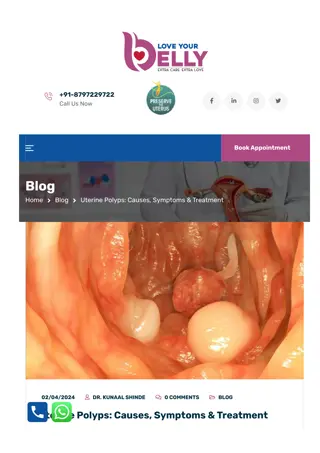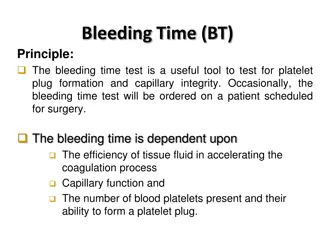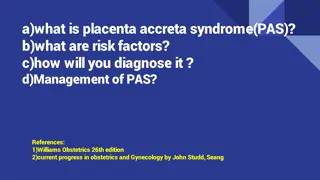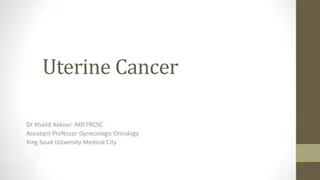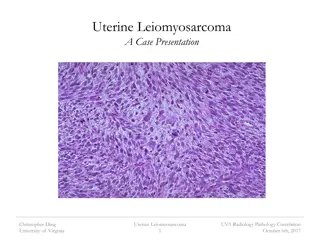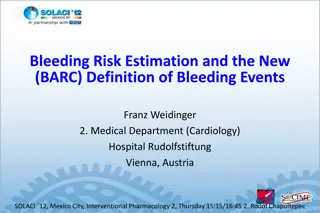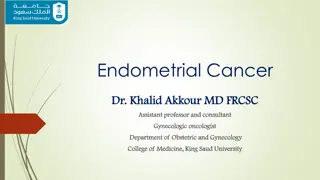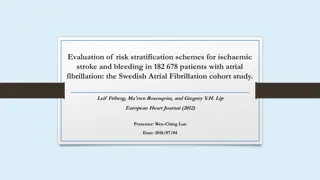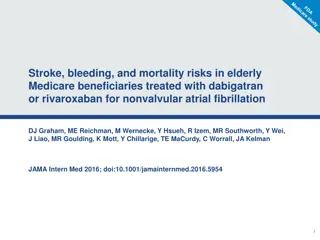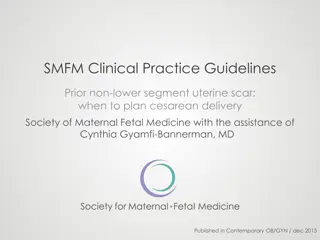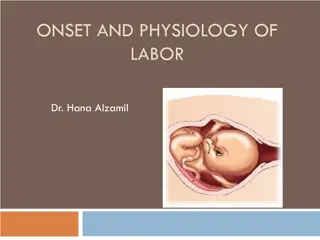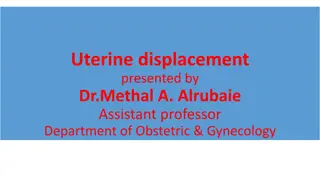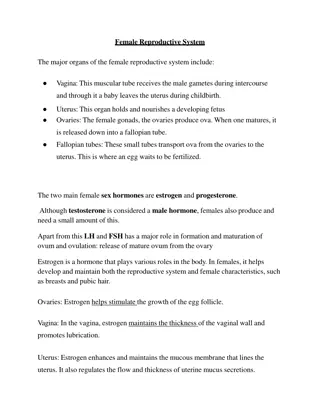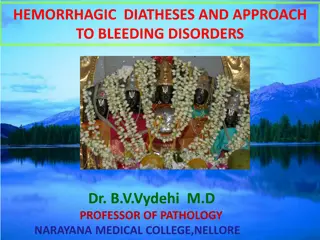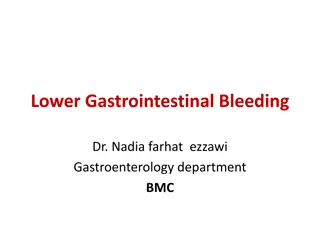Abnormal Uterine Bleeding in Reproductive-Age Women
Abnormal uterine bleeding manifests as irregular or heavy menstrual cycles and can be caused by various factors like pregnancy complications, endocrine abnormalities, or genital diseases. Diagnosis involves assessing the nature of bleeding and ruling out organic causes. Treatment depends on the underlying etiology, aiming to restore regular menstrual patterns and improve overall gynecological health.
Download Presentation

Please find below an Image/Link to download the presentation.
The content on the website is provided AS IS for your information and personal use only. It may not be sold, licensed, or shared on other websites without obtaining consent from the author.If you encounter any issues during the download, it is possible that the publisher has removed the file from their server.
You are allowed to download the files provided on this website for personal or commercial use, subject to the condition that they are used lawfully. All files are the property of their respective owners.
The content on the website is provided AS IS for your information and personal use only. It may not be sold, licensed, or shared on other websites without obtaining consent from the author.
E N D
Presentation Transcript
Case 1 C/O Irregular menses x 6 months 23 yo G1P1 2 menses in past 6 months, heavier and longer than normal. Menses previously regular since menarche No contraception x 3 years, desires pregnancy 15 kg weight gain since birth of 3 year old daughter
Case 2 C/O: Heavy menses x 4 months 44 yo G1P1. Normal, regular menses until 4 months ago PMH: negative PSH: BTL Meds: none
DEFINITION Any deviation in normal frequency, duration or amount of menstruation in women of reproductive age. NORMAL MENSES Normal Abnormal <2d, >7d Duration 4-6 days Volume 30-35cc >80cc Cycle length 21-35d <21d, >35
CLINICAL TYPES Polymenorrhoea Oligomenorrhea Menorrhagia Metrorrhagia Menometrorrhagia Intermenstual bleeding Hypomenorrhoea
CAUSES . Dysfunctional uterine bleeding . Pregnancy complications . Genital disease Tumors Endometriosis . Infection IUCD. . Prolapse . Extragenital .Endocrine. Iatrogenic . Haematological Emotional . Chronic systemic disease. Obesity .
Dysfunctional uterine bleeding Definition Abnormal uterine bleeding in absence of pelvic organ disease or a systemic disorder Incidence 60 % of AUB
Endocrine abnormality Anovulatory 90% Insufficient follicles Inadequate proliferative or atrophic Persistent follicles Proliferative or hyperplastic Ovulatory 10% Short proliferative phase Normal Long proliferative phase Normal Insufficient C. luteum leading to short luteal phase Persistent C luteum leading to Irregular shedding long luteal phase Endometrium Irregular or deficient secretory
Diagnosis Aim: 1. Nature & severity of bleeding 2. Exclusion of organic causes 3. Ovulatory or anovulatory How: History Examination Investigations
Life Phase Ovulatory Status Etiology R/O Pregnancy Adolescent Likely anovulation Consider bleeding disorder Pregnancy Ovulatory (Secretory) Hormonal DUB Reproductive age Anovulatory (Proliferative) Anatomic (Usually DUB) Coagulopathy R/O Pregnancy Perimenopause Early EMB/TV Sono Postmenopause R/O Endometrial CA
I. History: 1. Personal: age, wishes of the patient 2. Menstrual 3. Obstetric 4. Past 5. Present: amount, duration, color, smell, relation to sexual intercourse, associated symptoms
II. Examination: 1. General: pallor, endocrinopathy, coagulopathy, pregnancy 2. Abdominal: liver, spleen, pelvi abdominal mass 3. Pelvic: origin of the bleeding, cause
III.Investigations Laboratory 1. CBC 2. B-hCG 3. Hormonal profile (Prolactin, TSH, FSH, LH, free & total T4) 4. Coagulation profile (Prothrombin time, partial thrmoplastin time, bleeding time, platelets, Von Willebrand factor) Local U/S D & C Pap smear Hysteroscopy Endometrial biopsy
Ultrasonography 1. TAS 2. TVS 3. Saline sonography
Endometrial biopsy Indications: .Between 20 & 40 .If endometrial thickness on TVS is >12mm, endometrial sample should be taken to exclude endometrial hyperplasia (Grade A). Failure to obtain sufficient sample for H/P does not require further investigation unless the endometrial thickness is >12 mm (Grade B) Aim: diagnosis of the type of the bleeding Advantages: An adequate & acceptable screening procedure in females under 40 yrs
Methods: As an outpatient procedure, without general anesthesia. 1.Pipelle curette 2.Sharman curette, Gravlee jet washer, Isac cell sampler 3.Accrette 4.vabra aspirator
D & C Indications: 1. Mandatory after 4o yrs 2. Persistent or recurrent bleeding between 20 & 40 yrs Aim: 1.Diagnosis of organic disease 2.Diagnosis of the type of the endometrium 3.Arrest of the bleeding Disadvantages: 1.Small lesions can be missed 2.The sensitivity of detecting intrauterine pathology is only 65%
Fractional curretage Indication: >40 yrs Method: 3 samples: endocervical, lower segment & upper segment
Hysteroscopy: Indications: Mandatory after 40 yrs 1. Erratic menstrual bleeding 2. Failed medical treatment 3. TVS suggestive of intrauterine pathology e.g. polyp, fibroid (Grade B)
Advantages over D &C 1.The whole uterine cavity can be visualized 2.Very small lesions such as polyps can be identified & biopsied or removed 3.Bleeding from ruptured venules & echymoses can be readily identified 4.The sensitivity in detecting intrauterine pathology is 98% 5.Outpatient procedure Disadvantages 1.Cost of the apparatus 2.Lack of availability or experience
Evaluation Tests Choices are extensive Not practical or cost effective to do every test They are not used as general screening tests for all women with DUB. Selection should be tailored to suspected causes from the history and physical exam. Stepwise process should be considered
Step One: Rapid assessment of vital signs Hemodynamically stable Hemodynamically unstable Step Two: (simultaneous with step 1) Baseline CBC, quantitative beta hCG
Step Three (adolescents): Low risk for intracavitary or cancerous lesion High coagulopathy risk coagulation profile if abnormal, further testing and consultation is warranted If screen is normal, a diagnosis of anovulatory DUB is assumed and appropriate therapy begun
Step Four (Adults): Transvaginal ultrasound Lesion present biopsy hysteroscopy No lesion High risk for neoplasia endometrial biopsy Low risk for neoplasia can assume DUB and treat
Step Five (Adults): Secretory endometrium >50% have polyp or submucosal fibroid next step is dx hysteroscopy lesion present biopsy/excision lesion absent consider systemic disease assume DUB and treat if disease absent
Step Six (Adults): Proliferative endometrium or hyperplasia without atypia assume DUB manage according to desired fertility Hyperplasia with atypia or CA treat accordingly
Treatment Medical I. Hormonal 1.Progestagen 2.Oestrogen 3.COCP 4.Danazol 5.GnrH agonist 6.Levo-nova (Merina) II. Non hormonal Prostaglandin synthetase inhibitors (PSI) (Ponstan) Antifibrinolytics (Cyclocapron) Ethamsylate (Diacynon) Surgical 1. Endometrial ablation 2. Hysterectomy
Strategy of treatment <20 yrs Medical Always First resort after endometrial biopsy Temporizing & if surgery is refused or imminent menopause Surgical Never Seldom, only if medical treatment fail First resort if bleeding is recurrent 20-40 yrs > 40 yrs
Medical treatment Antifibrinolytics: Tranexamic acid (Cyklokapron) Mechanism of action: The endometrium possess an active fibrinolytic system & the fibrinolytic activity is higher in menorrhagia. Effect: Greater reduction of menstrual bleeding than other therapies (PSI, oral luteal phase progestagen & etamsylate)(Cochrane library,2002).
Side effects: Dose related. Nausea , vomiting, diarrhea, dizziness. Rarely transient color vision disturbance, intracranial thrombosis. But, no evidence that tranxemic acid increases the risk in absence of past or family history of thrombophilia. Dose: 3-6 gm /d for the first 3 days of the cycle
PSI: Mechanism; the endometrium is a rich source of PGE2 & PGF2 & its concentrations are greater in menorrhagia. PSI decreases endometrial PG concentrations. Effect: PSI decreased menstrual blood by 24% & norethisterone by 20%. Dose: mefenamic acid (Ponstan) 500 mg tds during menses. Side effects: Nausea, vomiting, gastric discomfort, diarrhea, dizziness. Rarely: haemolytic anemia, thrombocytopenia. The degree of reduction of MBL is not as great as it is with tranxamic acid but PSI have a lower side effect profile.
Etamsylate (Dicynone) Mechanism of action: maintain capillary integrity anti-hyalurunidase activity inhibitory effect on PG Dose: 500 mg bid, starting 5 days before anticipated onset of the cycle & continued for 10 days Effect: 20% reduction in MBL. There is no conclusive evidence of the effectiveness of etamsylate in reducing menorrhagea (Grade A) Side effects: headache, rash, nausea
Hormonal treatment Acute bleeding Estrogen therapy Oral conjugated equine estrogens 10mg a day in four divided doses treat for 21 to 25 days medroxyprogesterone acetate, 10 mg per day for the last 7 days of the treatment if bleeding not controlled, consider organic cause OR 25 mg IV every 4 to 12 hours for 24 hours, then switch to oral treatment as above. Bleeding usually diminishes within 24 hours
Hormonal treatment Acute bleeding (continued) High dose estrogen-progestin therapy use combination OCP s containing 35 micrograms or less of ethinylestradiol four tablets per day treat for one week after bleeding stops may not be as successful as high dose estrogen treatment
Hormonal treatment Recurrent bleeding episodes combination OCP s one tablet per day for 21 days intermittent progestin therapy medroxyprogesterone acetate, 10mg per day, for the first 10 days of each month higher doses and longer therapy my be tried if no initial response prolonged use of high doses is associated with fatigue, mood swings, weight gain, lipid changes
Hormonal treatment Recurrent bleeding episodes (continued) Progesterone releasing IUD levonova, Mirena: Delivers 20ug LNG /d. for 5 yr Metraplant: T shaped IUCD & levonorgestrel on the shoulder & stem Azzam IUCD: Cu T & levonorgestrel on the stem Effect 1.Comparable to endometrial resection for management of DUB. 2.Superior to PSI & antifibrinolytics 3.May be an alternative to hysterectomy in some patients
Side effects 1. BTB in the first cycles 2. 20% develop amenorrhea within 1 yr 3. Functional ovarian cysts Special indications 1. Intractable bleeding associated with chronic illness 2. Ovulatory heavy bleeding
Hormonal treatment Danazol: Synthetic androgen with antioestrogenic & antiprogestagenic activity Mechanism; inhibits the release of pituitary GnRh & has direct suppressive effect on the endometrium Effect: reduction in MBL (more effective than PSI) & amenorhea at doses >400 mg/d
Side effects: headache, weight gain, acne, rashes, hirsuitism, mood & voice changes, flushes, muscle spasm, reduced HDL, diminished breast size. Rarely: cholestatic jaundice. I It is effective in reducing blood loss but side effects limit it to a second choice therapy or short term use only (Grade A) Dose: 200 mg/d
Hormonal treatment GnRh analog Treatment results in medical menopause Blood loss returns to pretreatment levels when discontinued Treatment usually reserved for women with ovulatory DUB that fail other medical therapy and desire future fertility Use add back therapy to prevent bone loss secondary to marked hypoestrogenism
Surgical treatment Endometrial ablation I.Hysteroscopic: 1. Laser 2. Electrosurgical: a. Roller ball b. Resection II.Non-hysteroscopic: 1. Thermachoice 2. Microwave.
Indications: 1. Failure of medical treatment 2. Family is completed 3. Uterine cavity <10 cm 4. Submucos fibroid <5 cm 5. Endometrium is normal or low risk hyperplasia. Complications 1. Uterine perforation 2. Bleeding 3. Infection. 4. Fluid overload 5. Gas embolism
Hysterectomy Indications: 1. Failure of medical treatment 2. Family is completed Routes: 1. Abdominal 2. Vaginal 3. Laparoscopic Advantages: 1. Complete cure 2. Avoidance of long term medical treatment 3. Removal of any missed pathology Disadvantages: 1.Major operation 2.Hospital admission 3.Mortality & morbidity
Case 1 23 yo G1P1 Oligomenorrhea 15 kg weight gain Desires fertility PMH: negative SH: husband in USA, due to return in 3 months
Physical Exam BP 136/82, Wt 95, BMI 31kg/m2 Normal Head, neck, heart, lung, abdominal exam Normal breast, pelvic exam No signs hyperandrogenism Skin: normal, no acne, no hirsuitism, no acanthosis nigricans Differential?
Differential Diagnosis Pregnancy Polycystic Ovary Disease Thyroid disease Prolactinoma
Labs HCG negative TSH 2.9 Prolactin normal LH/FSH normal DHEA sulfate normal Testosterone not done CBC normal GC/chlamydia negative Normal Pap within previous year




